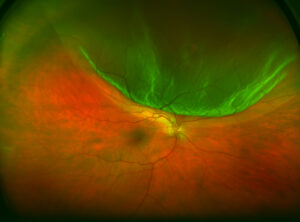Treatments
Scleral buckling

What is scleral buckling?
Scleral buckling is a surgical techniques that is performed in ophthalmology to reduce the diameter of the eyeball, relaxing the tension generated around the retina (the layer covering the back of the inside of the eye). This tension makes it easier to tear and become detached.
The surgery does not require entering the eye and consists of stitching a silicone ring to the sclerotic (soft part and outer wall of the eyeball) in order to press it and bring it closer to the retina. This relieves the traction effect on this delicate tissue, thus ensuring the retinal tear remains in the correct place, heals, and does not filter fluid.
To strengthen the effect of scleral buckling, we often have to seal the tears with cryocoagulation (cold treatment), diathermy (application of heat), or photocoagulation (laser therapy). We must also sometimes drain the fluid that has accumulated below the torn area.
Eye diseases treated by scleral buckling
This technique is recommended in the case of not very complex retinal tears or detachments. The operation should be performed quite urgently, because the longer it takes to reposition the retina the harder it is to position correctly, and the greater the risk of permanent vision damage.
Scleral buckling performed early and expertly in the cases selected avoids more invasive surgery such as vitrectomy, which does require handling intraocular structures.
Recovery
Scleral buckling is an outpatient surgery (no hospitalisation) that we often perform under local anaesthesia and sedation. The procedure takes between one and two hours and requires great experience by the surgeon.
During the first few days it is normal to notice irritation, redness and inflammation. To alleviate these symptoms, we will prescribe anti-inflammatory eye drops and antibiotic medication in eye drop form to avoid post-surgical infection.
You might also have the feeling that you have a foreign body or grit in your eye, blurred vision or floaters and flashes, which will all disappear progressively after a few days. After the operation we recommend you wear sunglasses to avoid intense light and make no sudden movements, although your specialist will fully explain all the guidelines you should follow.
